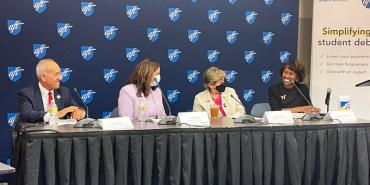As the landscape of student debt shifts, and more and more opportunities allow borrowers to have their debt relieved, the AFT is using every avenue to ensure that the word is out. In affiliate meetings, telephone town halls, media coverage and social media, the union is spreading the news, and at a student debt clinic at AFT headquarters in Washington, D.C., on Aug. 31, AFT President Randi Weingarten vowed to reach as many people as possible with information that could save them tens—and sometimes hundreds—of thousands of dollars.
What’s the news? The Biden administration is canceling $10,000 of federal student debt for individuals who earn less than $125,000 a year ($250,000, for a couple filing taxes jointly) and up to $20,000 for low-income borrowers who received Pell grants. Payments made on undergraduate loans through the newly announced income-driven repayment plan will be more manageable. Also, borrowers will no longer be overwhelmed with interest that accumulates even when they are faithfully making payments each month.
Plus: The payment pause put into effect at the beginning of the pandemic has also been extended to Dec. 31. And changes to Public Service Loan Forgiveness will continue to help public service workers like teachers and nurses get out from under debt many thought would last a lifetime.
Public Service Loan Forgiveness
“It is not enough that 175,000 people have gotten $8.3 billion of debt relief out of Public Service Loan Forgiveness,” said Weingarten, referring to recent numbers reported on debt relief—numbers that have actually now gone up to $10 billion. “We are not going to be happy until every single member, frankly every single person, who should be getting the benefits of Public Service Loan Forgiveness gets the benefits of Public Service Loan Forgiveness.”
Much of the recent student debt clinic focused on PSLF, which cancels federal student debt for people like teachers and school staff, college faculty and staff, healthcare workers and other public employees after they pay 10 years’ worth of student loan payments. Until recently the program was so broken that 98 percent of those who applied for relief were denied.
But thanks to a lawsuit against former Education Secretary Betsy DeVos—Weingarten v. DeVos—and ongoing advocacy from the AFT and others, improvements to the system have made it easier to navigate. A temporary waiver easing qualification requirements has enabled thousands of people who were denied relief another chance to apply successfully. As a result, borrowers all over the country are celebrating the end of their student debt.
There are, however, some caveats and deadlines: The waiver on PSLF requirements expires Oct. 31, 2022, in just two months, so the AFT is intensifying its efforts to reach members with information about it. In addition to offering expanded in-person student debt clinics through its affiliates, the AFT holds a weekly online debt clinic and provides free access to Summer, an online student loan management platform that has already helped thousands of AFT members apply for PSLF and other loan relief.
Outreach is key
Cindy Marten, deputy secretary of the Department of Education, praised the AFT for being such an instrumental partner in informing borrowers of the changes in the student loan relief programs. “The outreach is so important,” she said as she underscored the administration’s commitment to “turning Public Service Loan Forgiveness from a promise broken into a promise kept.”
“Post-high school education should be a ticket to a middle-class life, but for far too many people … the cost of borrowing has turned into a lifelong burden,” said Nasser Paydar, assistant secretary for post-secondary education. He joked that for his birthday—which is Oct. 31, the final day of the temporary PSLF waiver—he wants the gift of billions in loan relief for hundreds of thousands of borrowers.
Washington Teachers’ Union President Jacqueline Pogue Lyons remembered when she was paying back her student loans, payments were just $140 a month; she was able to buy a house and make repairs on her car when they were needed. So it shocked her when she talked to WTU teachers whose loan payments were $650 and $700 a month. She knows teachers who work at the baseball stadium or drive Uber after school hours to make ends meet.
Student debt clinics have made a huge difference for her members, said Lyons. “We have people cheering and yelling when they leave the debt clinics because they worked something out on the phone,” she said, describing how clinic participants can follow along with instructions and see what kind of relief is available even as they are learning about the details of how to access it.
The Aug. 31 workshop, like others around the country, led participants through the process of applying for loan relief, offering tips about how to navigate the system and giving examples of how previous participants were able to reduce their loan payments by hundreds of dollars a month. Chris Goff, an assistant director in the AFT’s higher education department who presented the clinic portion of the event, urged participants to spread the word about the debt relief available now.
Even if details are still confusing, he advised borrowers to use AFT tools to figure them out. “Don’t delay because you don’t know which plan works for you,” he said, noting that Summer, the free AFT member benefit, can guide borrowers through applying.
[Virginia Myers]


